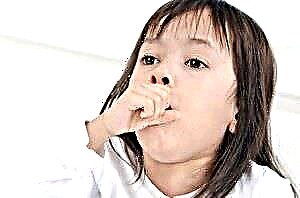Parents of infants often worry that their baby will catch chickenpox, and most often they are worried about how it will manifest itself in this case, especially if there is a patient nearby. But is it necessary for an infant to become infected, and in what forms can this infection proceed?

What is chickenpox?
First you need to decide what this disease is.
So, chickenpox (or simply “chickenpox”) is an infectious disease, which in children, as a rule, occurs in rather mild forms. Chickenpox in infants, adults, and immunocompromised people can take on much more complex forms.
The disease is transmitted by airborne droplets, and it can take from ten days to 21 days after contact with the patient until the first symptoms appear. Moreover, a person can infect others without even knowing that he is a carrier of the infection.
The danger of infection of others begins about a couple of days before the appearance of characteristic rashes on the skin, and it persists until new plaques cease to appear on the body, and the old abscesses are covered with crusts.
Symptoms
The first symptoms of chickenpox are redness of the skin (up to a centimeter in diameter), and blisters filled with clear liquid appear quite quickly in these places. In the future, they are transformed, taking the form of dried crusts.

Chickenpox in infants begins abruptly. Its signs are as follows:
- The rise in body temperature - up to 38 degrees, sometimes even up to 40;
- General weakness in the body;
- Headaches;
- Profuse rash that rapidly spreads to the surface of the skin and, which is characteristic, to the mucous membranes. This is the main symptom of chickenpox;
- The appearance on the skin of small blisters filled with a colorless and transparent liquid accompanies severe itching, and children usually do not tolerate it very well.
Where there can be a rash with chickenpox:the hairy part of the head, face, mouth, torso, genitals.
The course of this disease is usually wavy, and it is for this reason that rashes can appear at intervals of up to several times.
Mild form of chickenpox
If the chickenpox is mild, and usually it happens when the child is 3-6 months old, then first single abscesses appear on the baby's skin, and then it falls in waves with an increase in temperature. Moreover, the more rashes on the body, the higher it will be. When the elements of the rash are sporadic, the temperature may be normal.
Small red specks quickly become shiny bubbles, and red rims surround each of them. After 1-3 days, the bubbles become crusted. But at the same time, new rashes are present on the baby's skin. Often, mucous membranes also suffer - bubbles appear on them, but they quickly turn into surface erosion.
Chickenpox is difficult for a child due to the fact that the skin is itchy, which deprives him of peace, sound sleep and good appetite. The baby becomes very moody and irritable, refuses to breast and tries to tear apart a rash.
Mild treatment
Elements that appear on the skin should be treated with brilliant green so that they dry better. In addition, brilliant green tends to destroy the bacterial flora, and this prevents suppuration.
In order to reduce itching, the elements of the rash are lubricated "Fenistilom" (this gel is very effective in the treatment of chickenpox, since the drug significantly relieves allergic manifestations). But in no case, do not smear this gel all over the skin at once. With this drug, individual areas are treated in turn, especially where the rash is most common. And it is strictly forbidden to bathe the child during this period, since water procedures are fraught with the rapid spread of rashes over the entire body.
When a fresh rash appears, put on clothes on the baby, in which the sleeves are sewn or special baby mittens - the baby should not comb himself.
Severe chickenpox

Unfortunately, the severe course of this disease is quite common. In this case, chickenpox begins with an increase in temperature.
The kid becomes too restless, constantly refuses to eat. During this period, he may be tormented by headaches. Then the first elements of the rash appear. It often happens that many elements are poured out at the same time, and the temperature can even rise to 40 degrees. The condition of the baby improves somewhat after the first wave of rashes disappears, but after a day the situations are repeated. And several waves are waiting for the child.
Severe treatment
The main danger with chickenpox is damage to the mucous membranes. For example, if there is a rash in the larynx, your little one may develop signs of choking or false croup. If this happens, immediately call an ambulance, and before the arrival of the brigade, give the child a few drops of Fenistil (according to the instructions in the instructions for the drug).
In the absence of temperature, you can lower the baby's legs into a bowl of hot water - this will help relieve laryngeal edema due to the fact that the blood rushes to the legs. Of course, hot baths are categorically contraindicated at temperatures.
If the doctor describes the baby's condition as serious and tends to be hospitalized, do not refuse.
Chickenpox in infants is provoked by viruses belonging to the group of herpes viruses. Such viruses have a fairly high degree of susceptibility. The percentage of cases among people who have been in contact with the patient and have not had chickenpox before is 80 percent. Chickenpox is a typical childhood illness.
More about infant health
- Diathesis in infants (symptoms, treatment, folk remedies for diathesis)
- Staphylococcus aureus in infants (Symptoms, Treatment)
- Pimples on the face of a newborn - causes and how to get rid
- Miliaria in newborns ─ how to distinguish, how to prevent and what to do?



